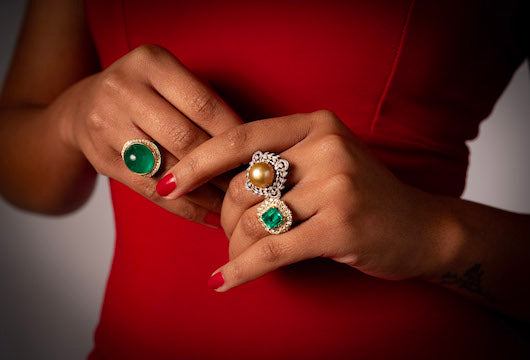Pearl Grading
The language of pearl grading is often dependent upon the location in which the pearls are being presented. While several systems of pearl grading exist, we adhere to the standards of the GIA, Cultured Pearl Association of America (CPAA), and commonly accepted industry language.
There are seven general pearl grading value factors: size, shape, color, luster, nacre, surface, and matching. Because there are several species of pearl producing organisms, the expectations of each variety are different, however, the pertinent value factors remain the same.
Sizing is distinguished by measuring in millimeters. With all other qualities being equal, the larger the size the more valuable the pearl. There is some overlap in possible sizes between species and varieties of pearls. Some sizes are so rare that creating a single piece of well crafted pearl jewelry may take many years.
Pearls may come in many shapes, with round being the most highly valued. Some of the other shapes are drop, oval, semi-baroque, baroque, circled, and near-round. Pearls may also come in many different natural colors. Pearl color consists of three components: Body color, which is the overall dominant color; overtone, which is one of more translucent colors that are just below the surface of a pearl; and orient, the multicolor iridescent glow for which pearls are famous. These three components contribute to the overall appearance, making for some very unique pearls.
Luster is measured by the radiant light reflections visible on a pearl’s surface. With all other qualities being equal, the most valuable pearls will have the highest luster. There are five grading categories to luster: Excellent - in which reflections appear bright and sharp; Very Good - reflections appear bright and near sharp; Good - reflections are bright but not sharp, and slightly hazy around the edges; Fair - reflections are weak and blurred; and lastly, Poor - reflections are dim and diffused.
Nacre is a quality that describes the thickness and evenness of the coating of a pearl. Nacre thickness may have a direct impact on the overall luster of a pearl, and as such these value factors are closely related. Some pearl producing regions enforce nacre thickness standards before exportation. Nacre that is thin may show the nucleus of a cultured pearl, having a dull or chalky undesirable appearance.
Surface quality has significant effects on a pearl’s value. The more spots, wrinkles, blemishes, or marks a pearl has, generally the lower the value. Because pearls are products of nature, it would be exceptionally rare for them to be perfect without surface characteristics. One might think of a pearl’s surface features as naturally occurring birthmarks, a result of the pearl’s unique formation.
The last value factor to consider when pearl grading is matching. This is not always applicable because pearl jewelry may be designed to either feature a single pearl, or to have several different types of pearls in one design. Overall, pearl matching will prioritize an aesthetically pleasing appearance.
These value factors are important when it comes to pearl grading, and equally as important is the type of pearl being graded. Not all pearls are available according to the same parameters.
Saltwater cultured pearls include Akoya, White and Golden South Sea, and Tahitian. Akoya pearls come from the Pinctada fucata martensii oyster, which lives along the coasts of Japan and China. They are typically round, with high luster, appearing in mostly white hues, with some rare light pastel colors. Sizes range from approximately 2.0 - 10.0mm, with larger sizes being exceptionally rare. White and Golden South Sea pearls come from the Pinctada maxima oysters, which are farmed off the coasts of Northern Australia, Indonesia, and the Philippine Islands. These pearls have a satin luster with mostly white and golden hues. Sizes range from approximately 8.0 - 20.0mm, with sizes over 15.0mm being exceptionally rare and valuable. Tahitian pearls are cultured from the Pinctada margaritifera oyster, which is mainly farmed in French Polynesia. These pearls come in many shapes, with round being the most valuable. They may have a high luster that appears almost metallic, coming in a variety of natural colors, mostly with a dark body color. The sizes range from approximately 8.0 - 16.0mm, with sizes over 15.0mm being exceptionally rare and of high value.
Freshwater pearls, cultured in the mussel Hyriopsis cumingii, are generally easier to produce in multitude than saltwater pearls. For this reason they are often priced at a lower premium. These pearls come in an overwhelming variety of shapes, including many fanciful and free-forms. The majority of freshwater pearls in the market are produced in China, can have a dull to high luster, and may come in a color range from white to a variety of naturally occurring pastel hues, but are often treated with dye for unnaturally vivid colors. The sizes range from 2.0 - 12.0mm, with rare larger sizes increasing in production to 15.0mm, as culturing technology advances.
In addition to saltwater and freshwater cultured pearls, there are also rare pearls on the market. Any of the pearl producing organisms may naturally produce a pearl, meaning they were not cultured with human interference, simply known by the distinction “natural pearl.” Other rare natural pearls include clam, conch, and melo melo.

